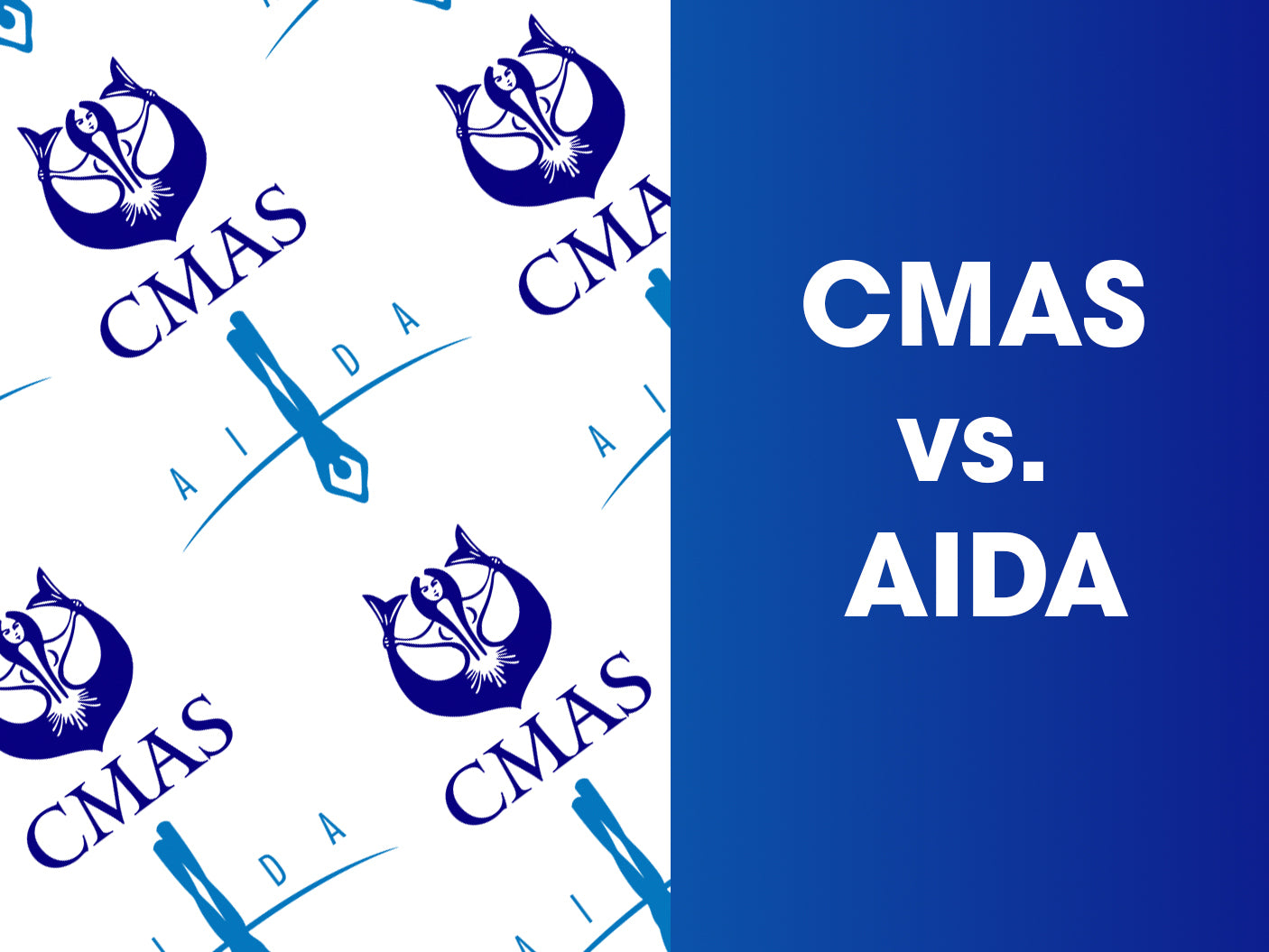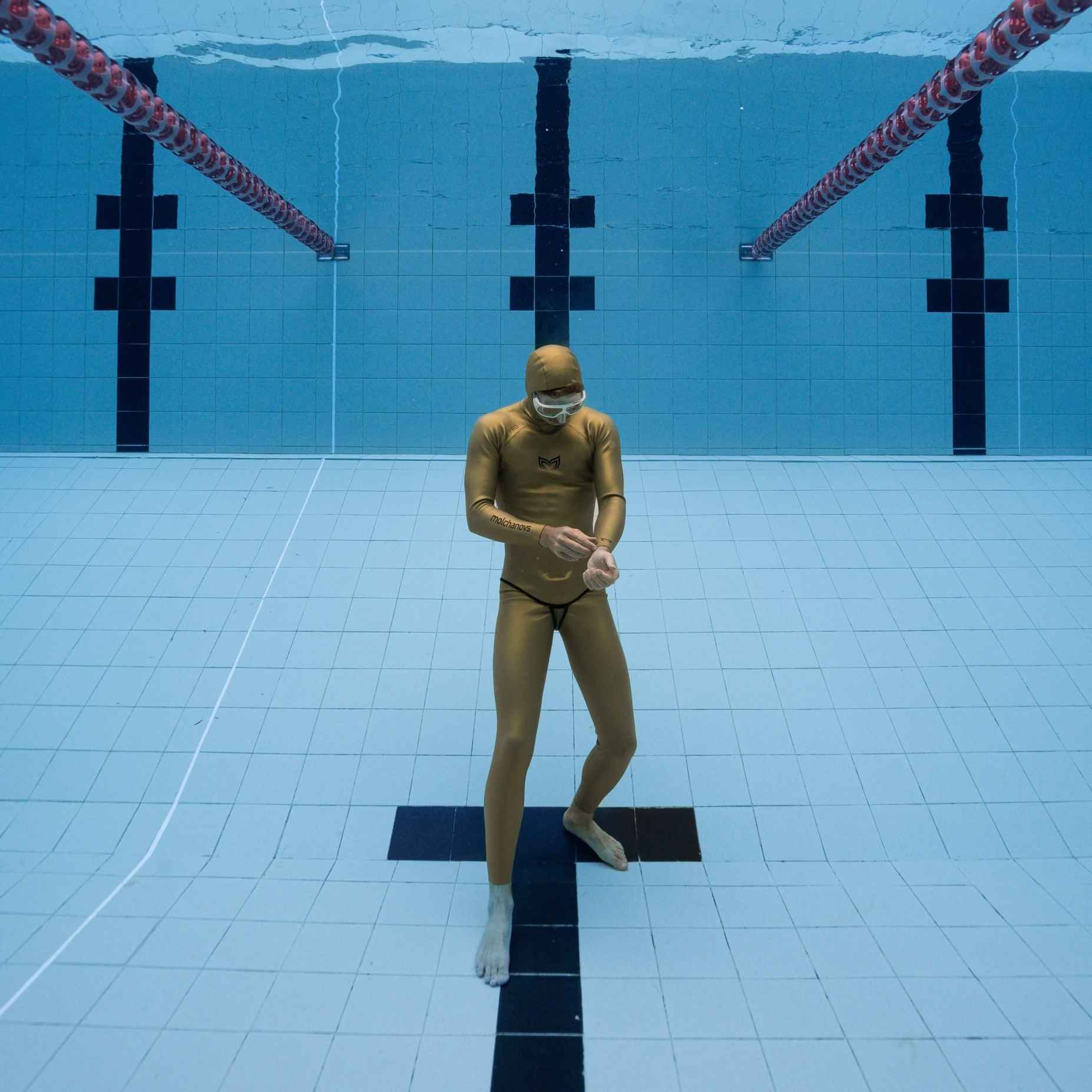International Freediving Federations You Need to Know: CMAS vs. AIDA

By Kristina Zvaritch and Asya Kleschevnikova
The competitive freediving world consists of two freediving record-governing bodies: CMAS and AIDA. But how much do you really know about each organization and the differences between them?
The more you understand, the more interesting watching freediving competitions will be!
Although freediving competitions have been held since the 1960s, it’s still difficult to find comprehensive information about each event, which is why we want to fill the gap for freediving fans everywhere! We’ll be publishing three articles to get you in the mood for competition - International Freediving Federations You Need to Know: CMAS vs AIDA, Current CMAS and AIDA Freediving World Records, and How to Make Sense of a Freediving Competition Broadcast.
In today’s article, we’ll let you know a bit about the history of both CMAS and AIDA, some information about the types of competitions each organization holds and their disciplines, and the main differences in their competition rules.
History of CMAS
CMAS, or Confédération Mondiale des Activités Subaquatiques in French (English - World Underwater Federation) is an international federation founded in 1959 with celebrated documentary filmmaker and underwater explorer Jaques Cousteau at its head. It was created to organize international underwater sporting events and leads the way in technical and scientific research and development. CMAS consists of three committees - sport, scientific, and technical, and is officially recognized by the International Olympic Committee (IOC).

Since freediving isn’t yet officially recognized as an Olympic sport, athletes commonly do not receive financial support from their national Ministries of Sports. However, some countries (such as Italy and France) support their top freediving athletes through national underwater federations that are members of CMAS.
Most of the earliest achievements made by freedivers were ratified by CMAS, including famous dives made by the legendary freedivers Jaques Mayol and Enzo Maiorca (which later inspired the freediving cult-classic film Le Grande Bleu). While CMAS stopped holding freediving competitions and ratifying records in the 1970s after a few high-profile accidents occurred, they resumed competitions as early as 2004 when the 2nd CMAS World Championship took place (we assume the first World Championship was in 2003, but we welcome freedivers who have a reliable site or article to send it to asya@molchanovs.com so we can provide more acurate information).
History of AIDA
After the release of Le Grande Bleu in 1988, freediving grew in popularity and the world saw many record attempts. However, rules weren’t standardized and safety wasn’t uniform throughout. Freedivers wanted to form a community and create safe environments for athletes to compete and set records - from this desire, AIDA was born.

AIDA, or Association Internationale pour le Développement de l’Apnée in French (English - International Association for the Development of Apnea) is a non-profit organization created in 1992 to help develop freediving as a sport. They created a stable set of rules and guidelines for freediving competitions and record attempts.
AIDA is a democratic organization comprised of an international assembly. The Executive Board oversees the Technical Commission, Educational Commission, Disciplinary Commission, and AIDA Judges and Instructors. The majority of work in AIDA is done by volunteers.
Competitions according to CMAS rules
CMAS includes both competitive and non-competitive disciplines, along with a discipline that was exclusive to CMAS. They are as follows:
CMAS pool disciplines
Static Apnea (STA) - Athletes lay face-down and horizontal on the surface of a pool and hold their breaths for as long as possible.
Dynamic Apnea (DYN) - Athletes perform a horizontal swim underwater for distance wearing bifins or a monofin.
Dynamic Apnea with Bi-Fins (DYN-BF) - Athletes perform a horizontal swim underwater for distance wearing bifins. No dolphin kicks are allowed except within the first 3m/10ft when a freediver starts and after each turn.
Dynamic Apnea without Fins (DNF) - Athletes perform a horizontal swim underwater for distance without fins. Instead, they use arm strokes and leg kicks.
Speed-Endurance (S&E) 16x50 and 8x50 - Athletes perform a horizontal swim underwater where they have to cover a fixed distance in the shortest time possible, passively recovering after each lap.
CMAS open water disciplines
Constant Weight (CWT) - Athletes freedive to depth wearing the same weight for descent/ascent. They can wear bifins or a monofin.
 5th CMAS Freediving Outdoor World Championship: CWT
5th CMAS Freediving Outdoor World Championship: CWT
Constant Weight with Bi-Fins (CWT-BF) - Athletes freedive to depth wearing the same weight for descent/ascent with bifins. No dolphin kicks are allowed except in the turning zone at the bottom.
 5th CMAS Freediving Outdoor World Championship: CWT-BF
5th CMAS Freediving Outdoor World Championship: CWT-BF
Constant Weight with No Fins (CNF) - Athletes freedive to depth wearing the same weight for descent/ascent without fins. Instead, they use arm strokes and leg kicks.
 5th CMAS Freediving Outdoor World Championship: CNF
5th CMAS Freediving Outdoor World Championship: CNF
Free Immersion (FIM) - Athletes freedive to depth pulling down/up the line wearing the same weight for descent/ascent.
 5th CMAS Freediving Outdoor World Championship: FIM
5th CMAS Freediving Outdoor World Championship: FIM
Variable Weight (VWT) - Athletes freedive to depth with a weighted sled for the descent and using bifins or a monofin for the ascent. This is no longer a competitive discipline and can only be performed for individual record attempts.
Jump Blue was also an open water CMAS discipline. It involved athletes using monofin or bifins to dive down to 10m (33ft) and swim around a square perimeter measuring 15m (49ft) on each side for distance. It was introduced in 2003, but was cancelled in 2017.
Pool and depth competitions held according to CMAS rules include national competitions held all over the world, the European Championships, and World Championships. Championship events and some national competitions are world-record status, meaning that they meet specific requirements and have special judges that can ratify world record attempts. Individual freedivers can also invite CMAS judges to ratify their world record attempts outside of competition.
What further separates CMAS from AIDA is the fact that they have multiple age categories for athletes ranging from 18 to 70+. They also classify disciplines according to the water conditions (DNF records are differentiated by performances in 25m/82ft and 50m/164ft pools), along with separating depth competitions by whether the dives were performed in freshwater, in the sea, and under ice. To view current CMAS World Records, see Current CMAS and AIDA Freediving World Records.
Competitions according to AIDA rules
AIDA has both competitive and non-competitive disciplines, which are as follows:
AIDA pool disciplines
Static Apnea (STA) - Athletes lay face-down and horizontal on the surface of a pool and hold their breaths for as long as possible.
 AIDA Korea National Championship 2023: STA
AIDA Korea National Championship 2023: STA
Dynamic Apnea (DYN) - Athletes perform a horizontal swim underwater for distance wearing bifins or a monofin.
 AIDA Korea National Championship 2023: DYN
AIDA Korea National Championship 2023: DYN
Dynamic Apnea with Bifins (DYNB) - Athletes perform a horizontal swim underwater for distance wearing bifins. No dolphin kicks are allowed. This discipline was only introduced in 2018.
 AIDA Korea National Championship 2023: DYNB
AIDA Korea National Championship 2023: DYNB
Dynamic Apnea with No Fins (DNF) - Athletes perform a horizontal swim underwater for distance without fins. Instead, they use arm strokes and leg kicks.
 AIDA Korea National Championship 2023: DNF
AIDA Korea National Championship 2023: DNF
AIDA open water disciplines
Constant Weight (CWT) - Athletes freedive to depth wearing the same weight for descent/ascent. They can wear bifins or a monofin.
Constant Weight with Bifins (CWTB) - Athletes freedive to depth wearing the same weight for descent/ascent with bifins. No dolphin kicks are allowed. This discipline was only introduced in 2018.
Constant Weight with No Fins (CNF) - Athletes freedive to depth wearing the same weight for descent/ascent without fins. Instead, they use arm strokes and leg kicks.
Free Immersion (FIM) - Athletes freedive to depth pulling down/up the line wearing the same weight for descent/ascent.
Variable Weight (VWT) - Athletes freedive to depth with a weighted sled for the descent and using bifins or a monofin for the ascent. This is no longer a competitive discipline and can only be performed for individual record attempts.
No Limit (NLT) - Athletes freedive to depth with a weighted sled for the descent and a buoyancy device for the ascent. This is the deepest and most dangerous discipline. As such, it’s no longer a competitive freediving discipline and attempts are not sanctioned by AIDA.
Pool and depth competitions held according to AIDA rules include national competitions and world championships. Similar to CMAS, AIDA freediving competitions can hold world record status and athletes can invite AIDA judges to witness and ratify individual world record attempts. What differentiates AIDA from CMAS is that AIDA also holds team competitions.
To view current AIDA World Records, see Current CMAS and AIDA Freediving World Records.
Main differences in competition rules
While there are a few minor differences in the way that CMAS and AIDA judge count points and assign cards (both organizations use a red card for disqualification, yellow for penalties, and white for a successful dive), the two main differences athletes must pay attention to is each organization’s surface protocol and the way they judge dolphin kicks in Dynamic/Constant Weight with Bifins disciplines.
CMAS surface protocol
In CMAS, athletes must complete the surface protocol in 20 seconds with no coaching allowed (i.e. the coach cannot tell an athlete to “breathe,” “take off your nose clip,” “show the OK sign,” etc.). The athlete must make the OK sign in the judge’s direction while keeping their airways above the water, and is additionally not allowed to let the back of their head touch the water (e.g., an athlete is so hypoxic that they lose their upright posture but keep their airways out of the water). More athletes favor the CMAS surface protocol over AIDA’s as it is easier to complete successfully.
AIDA surface protocol
The AIDA surface protocol is more strict than CMAS’ protocol, although coaching is allowed and the back of the athlete’s head is allowed to touch the water (as long as the airways stay clear of water!). Within 15 seconds of surfacing and without dipping their airways into the water, an athlete must perform the following actions in order:
- Remove all equipment covering the eyes and airways (mask, goggles, nose clip)
- Make a visible OK sign to the judge(s) with their pointer finger and thumb touching and the other three fingers in the air
- Say “I’m OK” or “I am OK” in English.
If an athlete does not perform the actions in order (for example, saying “I’m OK” before giving an OK sign), the surface protocol will be marked as incomplete and the athlete will be given a red card - even if the dive itself was successful.
DYN-BF / DYNB
In the Dynamic with Bi-Fins discipline, CMAS competition athletes are not allowed to use the dolphin kick except for the first 3m/10ft when they start and after each turn. If they perform a dolphin kick, they will be penalized. In AIDA competitions, the dolphin kick is not allowed at all in DYNB - if performed, it will result in the athlete’s disqualification.
CWT-BF / CWT
Similar to DYN-BF, in the Constant Weight with Bi-Fins discipline, athletes competing in a CMAS competition can only perform a dolphin kick in the 3m/10ft turning zone. In AIDA competitions, any dolphin kick in CWTB will result in disqualification.
Freediving in the Olympics
Did you know that freediving was once in the Olympics? Back in the 1900 Summer Olympic Games, athletes could compete in underwater swimming. French athlete Charles Devendeville dived a 60m (197ft) distance in 68.4 seconds on one breath and won the gold medal! However, the underwater sport was discontinued due to safety issues.
The hope for freediving to come back to the Summer Olympics is not gone from our hearts, though. Freediving is growing quickly in popularity in recent years, and freedivers everywhere are rooting for its inclusion once more. This is why Molchanovs wants to provide more freediving coverage and continue building the community - we believe all freedivers’ day in the Olympics will come!
Learn more
Want to learn more about freediving competitions? Stay tuned - next we’ll talk freediving world records in freediving!




Leave a comment